Physical Address
304 North Cardinal St.
Dorchester Center, MA 02124
The extensor apparatus consists of the quadriceps tendon, the patella, the patellar tendon, the infrapatellar fat pad, and the medial and lateral patellar retinacula.
The quadriceps tendon is the conglomeration of the distal tendons of the quadriceps muscle and usually has a striated appearance on sagittal MR images, with the anterior striation representing the contribution from the rectus femoris, the middle striations representing the vastus lateralis and medialis, and the deep striation representing the vastus intermedius muscles ( Fig. 28-1 ). The quadriceps tendon inserts on the anterior aspect of the superior pole of the patella.
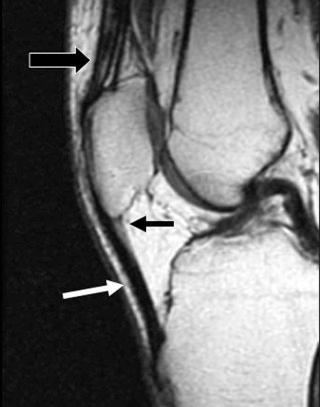
The quadriceps tendon typically tears in the unconditioned “weekend” athlete; in patients with systemic diseases such as diabetes, chronic renal failure, or rheumatoid arthritis; or in those on chronic corticosteroid therapy. It is more common in people more than 40 years of age than in teenagers or young adults.
The cause of tears is eccentric contraction of the extensor mechanism, usually due to stumbling, as the flexing knee tries to extend against the weight of the stumbling person. The ruptured tendon usually has some underlying abnormality such as tendinosis or generalized weakening due to a systemic chronic medical condition.
A lateral radiograph is the most useful projection and demonstrates soft tissue swelling and effacement of the fat planes, loss of the normal shadow of the quadriceps tendon, and varying amounts of anterior tilt of the patella away from the femur ( Fig. 28-2 ).
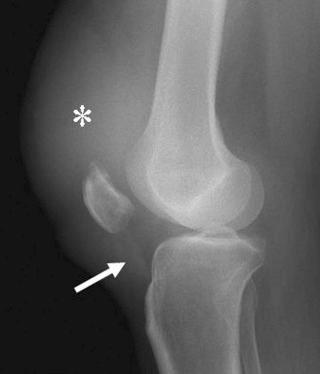
Acute rupture results in high–signal-intensity edema in and around the tear on T2-weighted images, and the proximal tendon edge may be retracted or “balled up.” Sagittal and coronal planes are useful to assess tendon discontinuity and degree of tendon retraction ( Fig. 28-3 ).
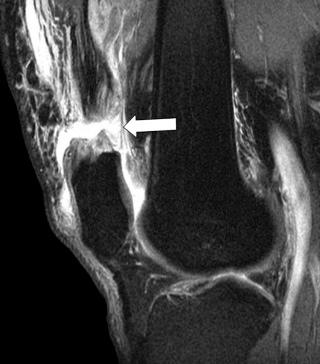
Longitudinal scanning is useful to assess tendon discontinuity and degree of retraction. In cases in which the torn edges are apposed, longitudinal scanning with the knee flexed can distinguish a partial tear from a nonretracted rupture ( Fig. 28-4 ).
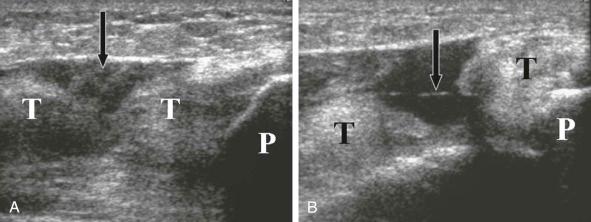
Partial tears and some nonretracted ruptures may be managed conservatively. Ruptures are usually surgically repaired.
Tendinosis refers to chronic degeneration of the tendon.
The patellar tendon is the continuation of the quadriceps tendon and is composed mostly of the rectus femoris component, which passes over the anterior aspect of the patella and inserts on the tibial tubercle (see Fig. 28-1 ). The normal patellar tendon is less than 75% of the thickness of the quadriceps tendon and has parallel surfaces. It is histologically a tendon, not a ligament.
Patellar tendinosis is seen in adults and may occur anywhere along the course of the tendon. The development of tendinosis is related to age and weight. Rupture most often occurs at the proximal aspect of the tendon, usually through an area weakened by tendinosis or previous surgery. Rupture of the tendon at its mid-portion is usually a result of a direct blow. Patellar tendon rupture is less common than quadriceps tendon rupture and tends to occur in younger adults, where it is more common in males than females. In older adults, the same systemic diseases that are risk factors for quadriceps tendon tear, namely diabetes, chronic renal failure, rheumatoid arthritis, and chronic corticosteroid therapy, are also risk factors for patellar tendon rupture.
Chronic overuse leads to areas of degeneration. A forceful tensile load during quadriceps contraction may cause the tendon to partially tear or rupture.
Histologically, tendon degeneration shows crimping and disorganization of collagen fibers and mucinous degeneration of collagen. Neovascularization due to angiofibroblastic proliferation may also be present.
Patellar tendinosis is usually asymptomatic. A patient with an acutely ruptured patellar tendon will complain of infrapatellar pain and swelling and inability to actively extend the knee.
The severely thickened patellar tendon may be seen on lateral radiographs of the knee as widening of the patellar tendon outline, but most foci of tendinosis are radiographically occult. In the case of tendon rupture, there is ill-defined soft tissue swelling with resultant loss of the outline of the tendon. The patella may be retracted proximally by the unopposed pull of the quadriceps muscle ( Fig. 28-5 ).
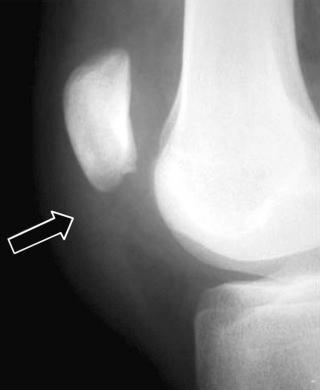
The appearance of patellar tendinosis is variable. There may be focal areas of intermediate signal intensity on T1- and T2-weighted images without focal tendon thickening. The degenerated tendon may also appear “wrinkled” or buckled (see eFig. 28-1 ) or may be diffusely thickened ( Fig. 28-6 ). A patellar tendon that is as thick as the quadriceps tendon is abnormal. Focal high signal intensity on T2-weighted images may result from marked mucinous degeneration and interstitial cyst formation.
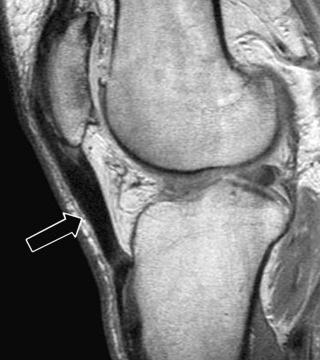
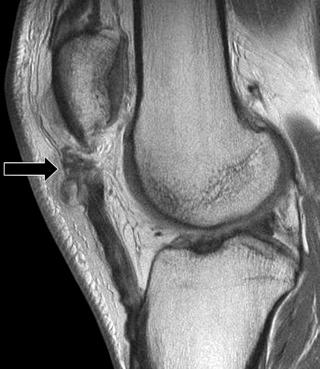
Acute rupture appears as discontinuity of the tendon with high–signal-intensity edema and hemorrhage in the region of tear. The patella may be retracted proximally.
Tendinosis may appear as focal hypoechoic loss of the normal echogenic fibrillar appearance of the tendon and/or tendon thickening ( Fig. 28-7 ). Rupture appears as discontinuity of the tendon.

Jumper's knee refers to a symptomatic focus of tendinosis and partial tearing that occurs in the proximal aspect of the patellar tendon.
“Jumper's knee” gets its name because it is seen in basketball players, volleyball players, and other athletes whose sport requires repetitive forceful extension of the knee. It usually occurs in teenagers and young adults.
Jumper's knee is a chronic overuse injury of the proximal aspect of the patellar tendon, due to repetitive forceful extension of the knee. It occurs in the proximal aspect of the tendon because the stress in the tendon is greatest at the tendon's insertion on the inferior pole of the patella.
There is mucoid degeneration of the collagen fibers and angiofibroblastic proliferation, with eventual partial tearing. The term tendinitis is a misnomer because there is no acute inflammation histologically.
The normal patellar tendon exhibits uniformly low signal intensity on all pulse sequences, except at its proximal attachment, where there may be a V-shaped focus of high signal intensity on T1-weighted images along its deep surface (see Fig. 28-1 ). On sagittal and axial T2-weighted MRI of jumper's knee, there is focal swelling of the proximal aspect of the patellar tendon, most often affecting the central third of the tendon, with focal internal high signal intensity ( Fig. 28-8 ). There may also be edema in the adjacent fat pad and in the inferior pole of the patella.
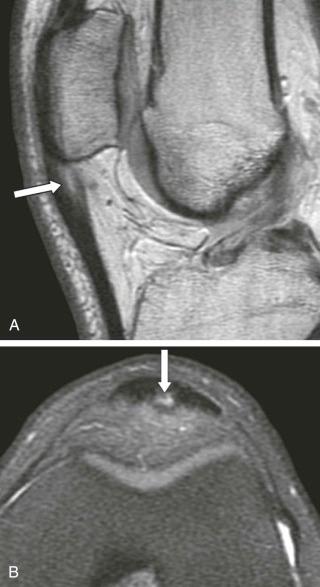
The normal patellar tendon exhibits an echogenic coarse fibrillar pattern. In jumper's knee, the fibrillar appearance is hypoechoic and the tendon is thickened. Power or color Doppler imaging reveals hyperemia, reflecting the degenerative angiofibroblastic proliferation ( Fig. 28-9 ).
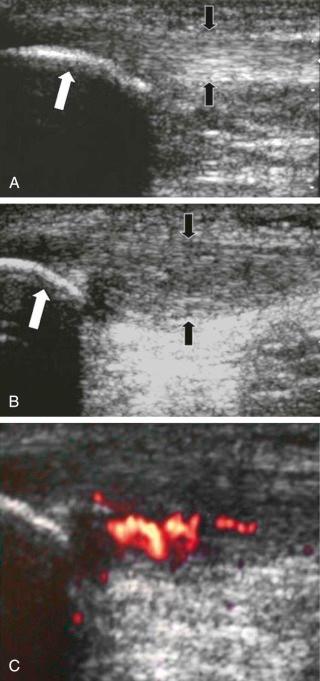
Initial treatment is conservative, consisting of rest, ice, and nonsteroidal anti-inflammatory medication. Percutaneous dry needling or sclerotherapy with sonographic guidance may also provide relief. Cases refractory to conservative treatment may be treated with resection of the tendinotic focus or shift of the patellar tendon attachment.
These abnormalities affect adolescents, before the patella is completely ossified and before the tibial tubercle apophysis has fused. Girls may be affected at a slightly younger age than boys.
Osgood-Schlatter disease (OSD) affects the distal aspect of the patellar tendon, whereas Sinding-Larsen-Johansson syndrome (SLJS) and patellar sleeve avulsion (PSA) affect the proximal aspect of the tendon.
OSD and SLJS are chronic overuse injuries, and PSA is an acute injury. All are seen in sports that involve forceful contraction of the extensor mechanism, as encountered in cutting maneuvers and jumping. There is controversy as to whether patella alta, patella infera, or tibial torsion predisposes to OSD by virtue of altered tensile stress on the patellar tendon/tibial tubercle apophyseal attachment.
PSA is a tear of the proximal aspect of the patellar tendon from the inferior pole of the incompletely ossified patella, with an osteochondral avulsion fragment of the patella. SLJS proximally and OSD distally represent repetitive partial tearing of the tendon and small avulsions of the cartilaginous attachment of the patellar tendon to the lower pole of the patella and tibial tubercle apophysis, respectively. The small avulsed cartilage fragments may ossify, and the small tendon tears may eventually develop foci of heterotopic ossification.
Lateral radiographs in PSA may belie the underlying injury, because most of the avulsed fragment is typically radiolucent cartilage, with only a small piece of bony patella. Soft tissue swelling may be present and the patella may be high riding.
Both OSD and SLJS demonstrate heterotopic ossification within the patellar tendon, but normal variations in development of the ossification centers of the tibial tubercle apophysis and lower pole of the patella may look similar. The distinguishing feature of these conditions from normal variation is the presence of tendon thickening and soft tissue swelling and the clinical presence of pain and tenderness in the affected region. A distended deep infrapatellar bursa may be visible as a soft tissue density deep to the tendon in OSD ( Fig. 28-10 ).
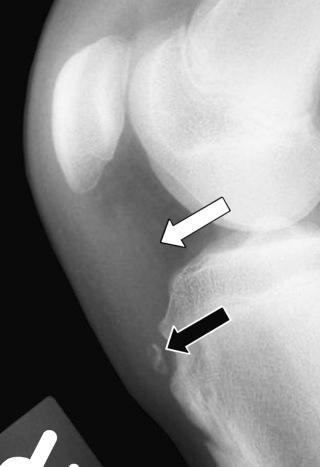
Sagittal T2-weighted images will display the fracture through the inferior pole of the patella in PSA and reveal the true extent of the fracture through the bone and cartilage anlage. On sagittal MR images of OSD and SLJS, the distal and proximal aspects, respectively, of the patellar tendon are enlarged, with low–signal-intensity foci of heterotopic ossification and possible enlargement or irregularity of the bony attachment site ( Figs. 28-11 and 28-12 ). In OSD there may also be distention of the deep infrapatellar bursa, manifest as fluid located between the anterior cortex of the tibia and the deep surface of the patellar tendon ( Fig. 28-13 ).
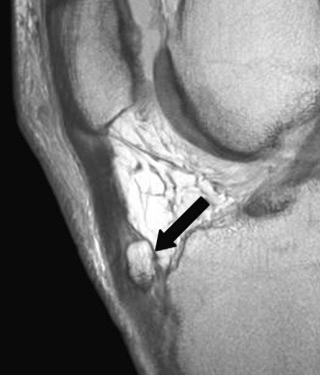
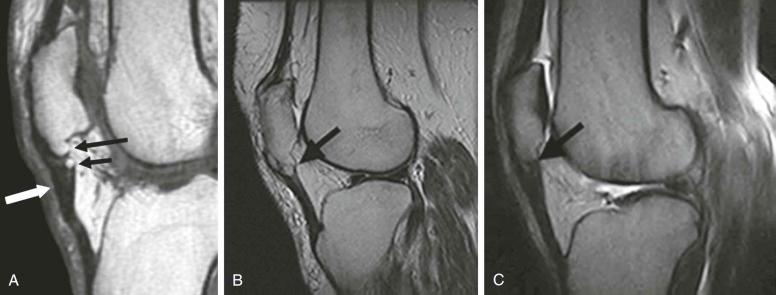
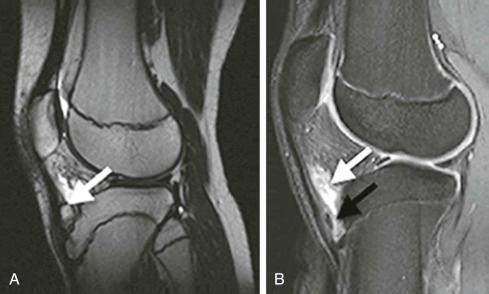
Longitudinal scanning of PSA demonstrates the echogenic fibrillar patellar tendon and attached piece of hypoechoic patellar cartilage separated from the rest of the patella. Longitudinal scanning in OSD and SLJS demonstrates the thickened tendon. The foci of internal heterotopic ossification will have echogenic surfaces with varying amounts of posterior acoustic shadowing ( Fig. 28-14 ). The distended deep infrapatellar bursa appears as a hypoechoic collection deep to the distal aspect of the tendon.

Patellar sleeve avulsion should be easily distinguished from other causes of acute knee pain in the adolescent because it is an acute event. The knee gives way, and the patient cannot stand or actively extend the knee. The area is painful and swollen, and there may be a palpable defect at the site of avulsion.
Patients with OSD and SLJS have chronic pain and tenderness to palpation over the affected region. Other causes of chronic anterior knee pain in the adolescent are jumper's knee, chondromalacia patellae, patellar tracking abnormalities, irritation of a medial or infrapatellar plica, and abnormalities of the Hoffa fat pad. Patellar tendon/lateral femoral condyle friction syndrome may affect adolescents but is more common in adults.
This abnormality usually occurs in young adults but has a reported age range of 13 to 56 years. Most people affected do not participate in routine athletic activities.
The biomechanics are not well understood, but may be related to an overuse injury in which the patellar tendon chronically rubs against the lateral femoral condyle or compresses the lateral aspect of the Hoffa fat pad against the lateral condyle. It is likely related to patellar maltracking or malalignment, because most patients with this abnormality have associated patella alta or lateral subluxation of the patella.
T2-weighted images demonstrate focal edema in the lateral aspect of the Hoffa fat pad, with an occasional focal fluid collection in this region. Marrow edema may be present in the lateral aspect of the patella, the cartilage of the lateral patellar facet may be thinned, and there may be tears in the proximal aspect of the patellar tendon.
The infrapatellar fat pad (also called the Hoffa fat pad) is a pyramidal fibrofatty structure located between the patella and femoral condyles superiorly and the tibia inferiorly. Its base is along the deep surface of the patellar tendon, and its apex points toward the intercondylar notch. The synovium of the anterior aspect of the knee joint is reflected over its deep surface, and thus the fat pad is intracapsular but extrasynovial. Synovial-lined vertical and horizontal clefts may be present within it.
The fat pad is not freely mobile but is attached to the inferior pole of the patella and the roof of the intercondylar notch by the ligamentum mucosum (also called the infrapatellar plica). It has attachments to the anterior horns of the menisci and to the periosteum of the tibia. The deep infrapatellar bursa is located at the inferior edge of the fat pad.
The blood supply of the fat pad comes from two vertically oriented and peripherally located vessels, which are branches of the superior and inferior genicular arteries with horizontal anastomotic branches. It is well innervated by branches of the femoral, common peroneal, and saphenous nerves.
A single traumatic episode or repetitive overuse due to hyperextension and rotational forces leads to hemorrhage and inflammation of the fat pad, which in turn cause swelling of the fat pad. The enlarged fat pad then gets impinged between the tibia and femur, further exacerbating the inflammation and enlargement.
Acutely, there is inflammation and hemorrhage of the fat pad. This gives way to an influx of macrophages and the deposition of fibrin and hemosiderin. Chronically, there is fibroblast proliferation, leading to fibrosis of the fat pad, which may undergo fibrocartilaginous metaplasia, and the fibrocartilaginous tissue may eventually ossify.
Become a Clinical Tree membership for Full access and enjoy Unlimited articles
If you are a member. Log in here